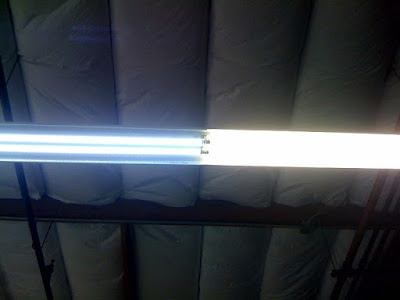Friday, June 26, 2009
Automated Demand Response - Free Money
Thursday, June 25, 2009
Direct LED Replacements for Flourescent Tube Lighting

The future of lighting is here today! Direct replacements for existing T-8 or T-12 fluorescent lamps are easy to install, and will start saving you money immediately.
- Reduced maintenance costs, LED tubes last up to 5x longer than fluorescent tubes (50,000 hours vs 20,000 hours); There are no ballasts required (none to replace); No hazardous materials (mercury or lead as with fluorescent) to dispose of.
- Reduced HVAC load, no ballast means no added heat to return plenums. All energy is converted to light. Heat gain from fluorescent tubes is approximately 590,000btu/tube/year (69kwh/tube/year) vs LEDs at about 132,000btu/tube/year (15.5kwh/tube/year).
- Flicker free lighting means reduced eye strain and headaches; Instant start, no warm-up time; Shatter-proof design means tubes will not break if dropped; No bugs ... LEDs do not emit UV light, so bugs are not attracted to them (ideal for outdoor use as well).
Tuesday, June 23, 2009
Green Jobs Workforce, Let's Get Ready
Sunday, June 14, 2009
Smartest Buildings Sense and Use Zone Level Information
Wednesday, June 10, 2009
Measurement Before Management
Monday, June 1, 2009
Energy Efficiency the Affordable First Step Towards Zero Net Energy
It may be quite glamorous and popular to install a roof full of solar panels, tap into a geothermal source, or harness the wind to power your home or business. However these types of “sexy systems” should be the last step of your Zero Net Energy project.
By doing some focused work up front to tune, upgrade, or replace inefficient components of your existing building systems you will be able to save a great deal of money by reducing the size (capacity) of your renewable energy system. In addition to the reduction in your project cost, you’ll also enjoy recurring savings on your monthly utility bill by increasing the energy efficiency of your building.
Begin with an energy audit to determine where your building’s strengths and weaknesses are. Your audit report should be very detailed, and include a prioritized list of solutions with budget costs and an expected return on investment (ROI).
Low cost solutions like weather stripping, insulation, door and window replacements or films can be done for a small fraction of the cost of a photovoltaic (PV) system.
Medium cost solutions like HVAC system maintenance and lighting upgrades (LED being the best choice right now) are still first phase projects and make great economic sense.
Higher cost solutions will still be less than you’d pay for a renewable energy system (especially if sized for an inefficient building) and must be done to lower your overall power consumption. DDC controls for HVAC, sub-metering, lighting controls, demand response controls, etc fall into this category.
Making your building as energy efficient as possible will lower your utility bill and earn you immediate monthly savings. Start banking those savings and put them towards your (now smaller and less costly) PV system. It will still be “sexy”, it will still get you to zero net energy, it just won’t cost as much.
Now, that was smart.
